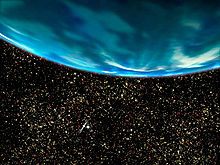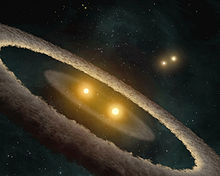- Circumbinary planet
-
 An artist's impression of the giant planet orbiting the binary system PSR B1620-26, which contains a pulsar and a white dwarf star and is located in the globular cluster M4.
An artist's impression of the giant planet orbiting the binary system PSR B1620-26, which contains a pulsar and a white dwarf star and is located in the globular cluster M4.
A circumbinary planet is a planet that orbits two stars instead of one. Because of the close proximity and orbit of some binary stars, the only way for planets to form is by forming outside the orbit of the two stars.[citation needed] Currently there are only five confirmed systems of circumbinary planets: PSR B1620-26, HW Virginis, Kepler-16, DP Leonis, and NN Serpentis.
Contents
Observations and discoveries
Confirmed planets
The first confirmed circumbinary extrasolar planet was found orbiting the system PSR B1620-26, which contains a millisecond pulsar and a white dwarf and is located in the globular cluster M4. The existence of the third body was first reported in 1993,[1] and was suggested to be a planet based on 5 years of observational data.[2] In 2003 the planet was characterised as being 2.5 times the mass of Jupiter in a low eccentricity orbit with a semimajor axis of 23 AU.[3]
Announced in 2008, the eclipsing binary system HW Virginis, comprising a subdwarf B star and a red dwarf, was announced to be the host of a planetary system. The inner and outer planets have masses at least 8.47 and 19.23 times that of Jupiter respectively, and have orbital periods of 9 and 16 years. The outer planet is sufficiently massive that it may be considered to be a brown dwarf under some definitions of the term,[4] but the discoverers argue that the orbital configuration implies it formed like a planet from a circumbinary disc. Both planets may have accreted additional mass when the primary star lost material during its red giant phase.[5]
On 15th September 2011, astronomers announced the discovery of a real planet that orbits two suns. The planet, called Kepler-16b, is about 200 light years from Earth, in the constellation Cygnus, and is believed to be a frozen world of rock and gas, about the size of Saturn. It orbits two stars that are also circling each other, one about two-thirds the size of our sun, the other about a fifth the size of our sun. Each orbit takes 229 days, while Kepler-16b orbits the system's center of mass every 225 days; the stars eclipse each other every three weeks or so. Scientists made the finding through NASA's Kepler spacecraft, which launched in 2009 and has been a driving force in the recent explosion in the discovery of distant planets.
Other observations
 An artist's impression of the binary star system HD 98800 B, which is surrounded by a disc that may be in the process of forming planets. HD 98800 B is itself a member of a quadruple star system.
An artist's impression of the binary star system HD 98800 B, which is surrounded by a disc that may be in the process of forming planets. HD 98800 B is itself a member of a quadruple star system.
Claims of a planet discovered via microlensing, orbiting the close binary pair MACHO-1997-BLG-41, were announced in 1999.[6] The planet was said to be in a wide orbit around the two red dwarf companions, but the claims were later retracted, as it turned out the detection could be better explained by the orbital motion of the binary stars themselves.[7]
Several attempts have been made to detect planets around the eclipsing binary system CM Draconis, itself part of the triple system GJ 630.1. The eclipsing binary has been surveyed for transiting planets, but no conclusive detections were made and eventually the existence of all the candidate planets was ruled out.[8][9] More recently, efforts have been made to detect variations in the timing of the eclipses of the stars caused by the reflex motion associated with an orbiting planet, but at present no discovery has been confirmed. The orbit of the binary stars is eccentric, which is unexpected for such a close binary as tidal forces ought to have circularised the orbit. This may indicate the presence of a massive planet or brown dwarf in orbit around the pair whose gravitational effects maintain the eccentricity of the binary.[10]
Circumbinary discs that may indicate processes of planet formation have been found around several stars, and are in fact common around binaries with separations less than 3 AU.[11][12] One notable example is in the HD 98800 system, which comprises two pairs of binary stars separated by around 34 AU. The binary subsystem HD 98800 B, which consists of two stars of 0.70 and 0.58 solar masses in a highly eccentric orbit with semimajor axis 0.983 AU, is surrounded by a complex dust disc that is being warped by the gravitational effects of the mutually-inclined and eccentric stellar orbits.[13][14] The other binary subsystem, HD 98800 A, is not associated with significant amounts of dust.[15]
List of circumbinary planets
Confirmed planets
Star system Planet Minimum mass
(MJ)Semimajor axis
(AU)Orbital period
(y)Discovered PSR B1620-26 b 2.5 23 100 2003 HW Virginis c 8.47 ± 0.42 3.62 ± 0.52 9.08 ± 0.22 2008 HW Virginis b 19.23 ± 0.24 5.30 ± 0.23 15.84 ± 0.14 2008 DP Leonis b 6.28 ± 0.58 8.6 23.8 2009 NN Serpentis c 6.91 ± 0.54 5.38 ± 0.20 15.50 ± 0.45 2010 NN Serpentis d 2.28 ± 0.38 3.39 ± 0.10 7.75 ± 0.35 2010 [16] Kepler-16 b 0.333 ± 0.016 0.7048 ± 0.0011 0.6266 ± 0.0001 2011 [17] Unconfirmed or doubtful
Star system Planetary object Mass
(MJ)Semimajor axis
(AU)Orbital period Discovered MACHO-1997-BLG-41 MACHO-1997-BLG-41 b ~3 ~7 ? 1999 Fiction
- In the Star Wars series, planet Tatooine orbits in a close binary system.
- In the Doctor Who series, planet Gallifrey orbits a binary star system.
- In the Star Fox series, the planets orbit Lylat and Solar (an M-class red dwarf)
References
- ^ Backer, D.C. (1993). "A pulsar timing tutorial and NRAO Green Bank observations of PSR 1257+12". Planets around Pulsars. Pasadena: California Institute of Technology. pp. 11–18. Bibcode 1993ASPC...36...11B.
- ^ Thorsett, S. E.; Arzoumanian, Z.; Taylor, J. H. (1993). "PSR B1620-26 - A binary radio pulsar with a planetary companion?". Astrophysical Journal Part 2. Letters 412 (1): L33–L36. Bibcode 1993ApJ...412L..33T. doi:10.1086/186933.
- ^ Sigurðsson, Steinn; Richer, Harvey B.; Hansen, Brad M.; Stairs, Ingrid H.; Thorsett, Stephen E. (2003). "A Young White Dwarf Companion to Pulsar B1620-26: Evidence for Early Planet Formation". Science 301 (5630): 193–196. arXiv:astro-ph/0307339. Bibcode 2003Sci...301..193S. doi:10.1126/science.1086326. PMID 12855802.
- ^ "Definition of a "Planet"". Working Group on Extrasolar Planets (WGESP) of the International Astronomical Union. http://www.dtm.ciw.edu/users/boss/definition.html. Retrieved 2009-07-04.
- ^ Lee, Jae Woo; Kim, Seung-Lee; Kim, Chun-Hwey; Koch, Robert H.; Lee, Chung-Uk; Kim, Ho-Il; Park, Jang-Ho (2009). "The sdB+M Eclipsing System HW Virginis and its Circumbinary Planets". The Astronomical Journal 137 (2): 3181–3190. Bibcode 2009AJ....137.3181L. doi:10.1088/0004-6256/137/2/3181.
- ^ Bennett, D. P.; Rhie, S. H.; Becker, A. C.; Butler, N.; Dann, J.; Kaspi, S.; Leibowitz, E. M.; Lipkin, Y.; Maoz, D.; Mendelson, H.; Peterson, B. A.; Quinn, J.; Shemmer, O.; Thomson, S.; Turner, S. E. (1999). "Discovery of a planet orbiting a binary star system from gravitational microlensing". Nature 402 (6757): 57–59. arXiv:astro-ph/9908038. Bibcode 1999Natur.402...57B. doi:10.1038/46990.
- ^ Albrow, M. D.; Beaulieu, J.-P.; Caldwell, J. A. R.; Dominik, M.; Gaudi, B. S.; Gould, A.; Greenhill, J.; Hill, K.; Kane, S.; Martin, R.; Menzies, J.; Naber, R. M.; Pollard, K. R.; Sackett, P. D.; Sahu, K. C.; Vermaak, P.; Watson, R.; Williams, A.; Bond, H. E.; van Bemmel, I. M. (2000). "Detection of Rotation in a Binary Microlens: PLANET Photometry of MACHO 97-BLG-41". The Astrophysical Journal 534 (2): 894–906. arXiv:astro-ph/9910307. Bibcode 2000ApJ...534..894A. doi:10.1086/308798.
- ^ "The TEP network". http://www.iac.es/project/tep/tephome.html.
- ^ Doyle, Laurance R.; Deeg, Hans J.; Kozhevnikov, Valerij P.; Oetiker, Brian; Martín, Eduardo L.; Blue, J. Ellen; Rottler, Lee; Stone, Remington P. S.; Ninkov, Zoran; Jenkins, Jon M.; Schneider, Jean; Dunham, Edward W.; Doyle, Moira F.; Paleologou, Efthimious (2000). "Observational Limits on Terrestrial-sized Inner Planets around the CM Draconis System Using the Photometric Transit Method with a Matched-Filter Algorithm". The Astrophysical Journal 535 (1): 338–349. arXiv:astro-ph/0001177. Bibcode 2000ApJ...535..338D. doi:10.1086/308830.
- ^ Morales, Juan Carlos; Ribas, Ignasi; Jordi, Carme; Torres, Guillermo; Gallardo, José; Guinan, Edward F.; Charbonneau, David; Wolf, Marek; Latham, David W.; Anglada-Escudé, Guillem; Bradstreet, David H.; Everett, Mark E.; O'Donovan, Francis T.; Mandushev, Georgi; Mathieu, Robert D. (2009). "Absolute Properties of the Low-Mass Eclipsing Binary CM Draconis". The Astrophysical Journal 691 (2): 1400–1411. Bibcode 2009ApJ...691.1400M. doi:10.1088/0004-637X/691/2/1400.
- ^ Ker Than (2007-03-07). "Worlds with Double Sunsets Common". Space.com. http://www.space.com/scienceastronomy/070329_double_sunsets.html.
- ^ Trilling, D. E.; Stansberry, J. A.; Stapelfeldt, K. R.; Rieke, G. H.; Su, K. Y. L.; Gray, R. O.; Corbally, C. J.; Bryden, G.; Chen, C. H.; Boden, A.; Beichman, C. A. (2007). "Debris disks in main-sequence binary systems.". The Astrophysical Journal 658 (2): 1264–1288. arXiv:astro-ph/0612029. Bibcode 2007ApJ...658.1289T. doi:10.1086/511668.
- ^ Akeson, R. L.; Rice, W. K. M.; Boden, A. F.; Sargent, A. I.; Carpenter, J. M.; Bryden, G. (2007). "The Circumbinary Disk of HD 98800B: Evidence for Disk Warping". The Astrophysical Journal 670 (2): 1240–1246. Bibcode 2007ApJ...670.1240A. doi:10.1086/522579.
- ^ Verrier, P. E.; Evans, N. W. (2008). "HD 98800: a most unusual debris disc". Monthly Notices of the Royal Astronomical Society 390 (4): 1377–1387. Bibcode 2008MNRAS.390.1377V. doi:10.1111/j.1365-2966.2008.13854.x.
- ^ Prato, L.; Ghez, A. M.; Piña, R. K.; Telesco, C. M.; Fisher, R. S.; Wizinowich, P.; Lai, O.; Acton, D. S.; Stomski, P. (2001). "Keck Diffraction-limited Imaging of the Young Quadruple Star System HD 98800". The Astrophysical Journal 549 (1): 590–598. arXiv:astro-ph/0011135. Bibcode 2001ApJ...549..590P. doi:10.1086/319061.
- ^ Schneider, J. "Notes for star NN Ser". The Extrasolar Planets Encyclopaedia. http://www.exoplanet.eu/planet.php?p1=NN+Ser+%28ab%29&p2=c. Retrieved 2010-10-22.
- ^ Laurance R. Doyle et al.. "Kepler-16: A Transiting Circumbinary Planet". http://arxiv.org/abs/1109.3432.
Further reading
- Planets in Binary Star Systems, Nader Haghighipour, Springer, 2010, ISBN 9789048186860
Exoplanets Classes Chthonian planet • Carbon giant • Eccentric Jupiter • Helium planet • Hot Jupiter • Hot Neptune • Jovian planet • Puffy planetOther typesCircumbinary planet • Goldilocks planet • Pulsar planetSystems Binary star • Extragalactic planet • Extrasolar moon • Hypothetical extrasolar planet • Planetary system • Rogue planet • Trojan planetLists DetectionExtrasolar planets detected by radial velocity • Transiting extrasolar planets • Extrasolar planets detected by microlensing • Extrasolar planets directly imaged • Extrasolar planets detected by timing • Unconfirmed exoplanetsPlanets and host starsStars with extrasolar planets • Planetary systems • Extrasolar planet extremes • Extrasolar planet firsts • List of nearest terrestrial exoplanetsSurveys Exoplanets search projects Ground-based AAPS • California and Carnegie Planet Search • HAT • HARPS, part of the Geneva Extrasolar Planet Search • MEarth Project • MOA • OGLE • Magellan Planet Search Program • SuperWASP • TrES • XO Telescope • EAPSNet • High Resolution Echelle Spectrometer (HIRES) • MARVELS • MUSCA • Microlensing Follow-Up Network (MicroFUN) • NASA-UC Eta-Earth • PHASES • PlanetPol • PARAS • Subaru telescope, using the High-Contrast Coronographic Imager for Adaptive Optics (HiCIAO) • Systemic, an amateur search project • ZIMPOL/CHEOPS, based at the VLTSpace Missions CurrentPlannedPEGASE (est. 2010-2012) • TESS (est. 2013-2014) • PLATO (est. 2017) • New Worlds (est. 2020) • EChO (est. 2022)Other statusSee also: Discoveries of extrasolar planets Categories:- Exoplanetology
- Types of planet
- Binary stars
- Lists of planets
Wikimedia Foundation. 2010.
